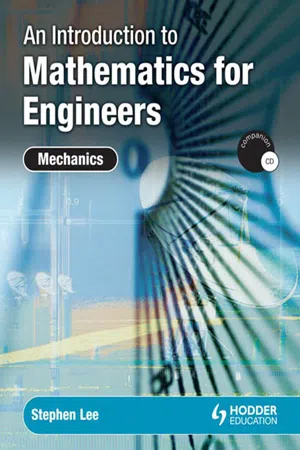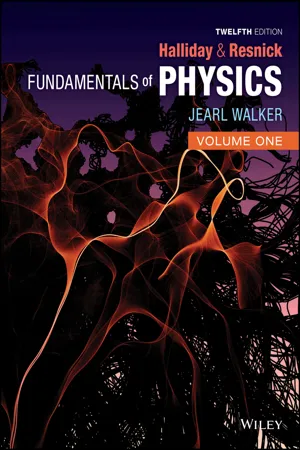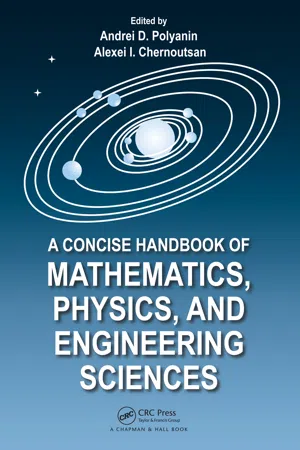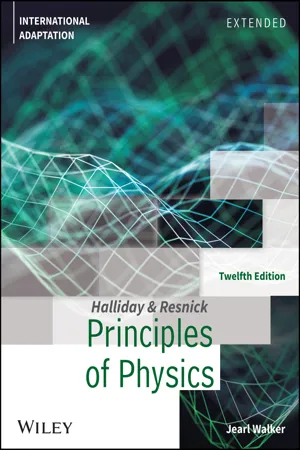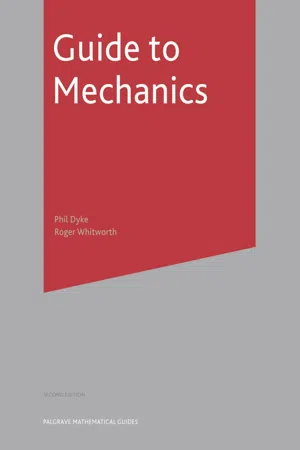Physics
Force and Potential Energy
Force is a push or pull acting on an object, causing it to accelerate. Potential energy is the energy stored in an object due to its position or configuration. In the context of physics, force and potential energy are related concepts, with force being the agent that can change an object's potential energy by doing work on it.
Written by Perlego with AI-assistance
Related key terms
1 of 5
10 Key excerpts on "Force and Potential Energy"
- eBook - PDF
- David Halliday, Robert Resnick, Jearl Walker(Authors)
- 2020(Publication Date)
- Wiley(Publisher)
150 What Is Physics? One job of physics is to identify the different types of energy in the world, especially those that are of common importance. One general type of energy is potential energy U. Technically, potential energy is energy that can be associated with the configuration (arrangement) of a system of objects that exert forces on one another. C H A P T E R 8 Potential Energy and Conservation of Energy 8-1 POTENTIAL ENERGY Learning Objectives After reading this module, you should be able to . . . ● A force is a conservative force if the net work it does on a particle moving around any closed path, from an initial point and then back to that point, is zero. Equivalently, a force is conservative if the net work it does on a particle moving between two points does not depend on the path taken by the particle. The gravitational force and the spring force are conservative forces; the kinetic frictional force is a nonconservative force. ● Potential energy is energy that is associated with the configuration of a system in which a conservative force acts. When the conservative force does work W on a particle within the system, the change ∆U in the potential energy of the system is ∆U = −W. If the particle moves from point x i to point x f , the change in the potential energy of the system is ΔU = − ∫ x f x i F(x) dx. ● The potential energy associated with a system consist- ing of Earth and a nearby particle is gravitational potential energy. If the particle moves from height y i to height y f , the change in the gravitational potential energy of the particle–Earth system is ∆U = mg( y f − y i ) = mg ∆y. ● If the reference point of the particle is set as y i = 0 and the corresponding gravitational potential energy of the system is set as U i = 0, then the gravitational potential energy U when the particle is at any height y is U( y) = mgy. ● Elastic potential energy is the energy associated with the state of compression or extension of an elastic object. - eBook - PDF
- Stephen Lee(Author)
- 2014(Publication Date)
- CRC Press(Publisher)
● The kinetic energy of a moving object 1 2 mass ( speed ) 2 . Potential energy is the energy which a body possesses because of its position. It may be thought of as stored energy which can be converted into kinetic or other forms of energy. You will meet this again on page 208. The energy of an object is usually changed when it is acted on by a force. When a force is applied to an object which moves in the direction of its line of action, the force is said to do work. For a constant force this is defined as follows. ● The work done by a constant force force distance moved in the direction of the force . The following examples illustrate how to use these ideas. A brick, initially at rest, is raised by a force averaging 40 N to a height 5 m above the ground where it is left stationary. How much work is done by the force? S OLUTION The work done by the force raising the brick is 40 5 200 J. Figure 9.1 Examples 9.2 and 9.3 show how the work done by a force can be related to the change in kinetic energy of an object. A train travelling on level ground is subject to a resisting force (from the brakes and air resistance) of 250 kN for a distance of 5 km. How much kinetic energy does the train lose? 5 m 40 N 202 AN INTRODUCTION TO MATHEMATICS FOR ENGINEERS : MECHANICS E XAMPLE 9.1 E XAMPLE 9.2 S OLUTION The forward force is 250 000 N. The work done by it is 250 000 5000 1 250 000 000 J. Hence 1 250 000 000 J of kinetic energy are gained by the train, in other words 1 250 000 000 J of kinetic energy are lost and the train slows down. This energy is converted to other forms such as heat and perhaps a little sound. A car of mass m kg is travelling at u ms 1 when the driver applies a constant driving force of F N. The ground is level and the road is straight and air resistance can be ignored. The speed of the car increases to v ms 1 in a period of t s over a distance of s m. - eBook - PDF
- David Halliday, Robert Resnick, Jearl Walker(Authors)
- 2021(Publication Date)
- Wiley(Publisher)
● If the reference point of the particle is set as y i = 0 and the corresponding gravitational potential energy of the system is set as U i = 0, then the gravitational potential energy U when the particle is at any height y is U( y) = mgy. ● Elastic potential energy is the energy associated with the state of compression or extension of an elastic object. For a spring that exerts a spring force F = −kx when its free end has displacement x, the elastic potential energy is U(x) = 1 _ 2 kx 2 . ● The reference configuration has the spring at its relaxed length, at which x = 0 and U = 0. 187 8.1 POTENTIAL ENERGY What Is Physics? One job of physics is to identify the different types of energy in the world, especially those that are of common importance. One general type of energy is potential energy U. Technically, potential energy is energy that can be associated with the configuration (arrangement) of a system of objects that exert forces on one another. This is a pretty formal definition of something that is actually familiar to you. An example might help better than the definition: A bungee-cord jumper plunges from a staging platform (Fig. 8.1.1). The system of objects consists of Earth and the jumper. The force between the objects is the gravitational force. The configuration of the system changes (the separation between the jumper and Earth decreases— that is, of course, the thrill of the jump). We can account for the jumper’s motion and increase in kinetic energy by defining a gravitational potential energy U. This is the energy associated with the state of separation between two objects that attract each other by the gravitational force, here the jumper and Earth. When the jumper begins to stretch the bungee cord near the end of the plunge, the system of objects consists of the cord and the jumper. The force between the objects is an elastic (spring-like) force. The configuration of the system changes (the cord stretches). - Andrei D. Polyanin, Alexei Chernoutsan(Authors)
- 2010(Publication Date)
- CRC Press(Publisher)
Let us define the difference between the potential energies of the particle as the work performed by the field to move the particle from one position to another: E p ( r 1 ) – E p ( r 2 ) = A 12 . (P1. 5 . 2 . 1 ) This work is independent of the path. Hence, the change in the potential energies , E 2 – E 1 , equals the negative of the work done by the field. If the particle is moved very slowly by an external force, then the work performed by the external force is equal in magnitude and opposite in sign to the work of the field, so A e 12 = E 2 – E 1 in accordance with the general principle (P1.5.1.1). Equation (P1.5.2.1) defines the difference of potential energies; so the potential energy is defined up to an additive constant. To make the definition unambiguous, one should specify the value (usually zero) of the potential energy at some point in space. Example 1. The work done by the force of gravity m g on lifting a particle of mass m from height h 1 to height h 2 is equal to mgh 1 – mgh 2 . Consequently, the potential energy of the particle in the gravitational field is E p = mgh , where the height is counted off from a chosen zero level. The potential energy of a system of points in the field of gravity equals E p = summationdisplay j m j gh j = mg ∑ j m j h j m = mgh cm , where m is the mass of the system and h cm is the height of its center of mass. Example 2. The work done by the elastic force equals integraltext x 2 x 1 (– kx ) dx = 1 2 kx 2 1 – 1 2 kx 2 2 , where x 1 and x 2 are the initial and final points of the spring deformation. Consequently, the potential energy of the elastic spring is E p = 1 2 kx 2 , where zero energy corresponds to the undeformed spring. Example 3. The work done by friction or resistive forces is negative on each segment of the path and also along a closed path. Consequently, these forces do not satisfy the condition of being conservative and are nonconservative.- eBook - PDF
- Richard C. Hill, Kirstie Plantenberg(Authors)
- 2013(Publication Date)
- SDC Publications(Publisher)
One definition of work is “The amount of energy transferred by a force acting through a distance.” What does that mean in the context of dynamics? If a force is applied to a particle and the force causes that particle to move through a distance, the force has done work. This also means that the force has transferred some energy to (or from) the particle. Energy is the capacity of a particle to do work, which makes sense. If you put energy into a particle, then that particle now has the ability to do work. A particle can possess different forms of energy. The two forms related to dynamics that we will be discussing are the energy of motion (kinetic energy) and the energy of position (potential energy). So what is the difference between work and energy? Work and energy possess the same units (Joules) and they are related in that work is the process of a force transferring energy, while energy is a measure of the ability of a system to do work. Work doesn’t always have to add energy to a system, it can also take energy from a system. Consider that you are driving a car down the road at 70 mph. The car has the energy of its motion (kinetic energy). A deer crosses your path and you slam on the brakes causing you to skid. The friction force that develops between your tires and the road slows your car to an eventual stop. The friction force is applied over a distance (the stopping distance), therefore, it does work. The work done takes energy out of the car, which means that the work is negative. Now that we have a physical understanding of what work is, let’s go back and look at Equation 7.1-1 and attempt to gain a mathematical understanding of the work equation. Equation 7.1-1 states that the work U done by an external force F being applied to the particle is equal to the integral of the dot product of F with the differential change in position dr. - David Halliday, Robert Resnick, Jearl Walker(Authors)
- 2023(Publication Date)
- Wiley(Publisher)
(8.1.9) Elastic Potential Energy Elastic potential energy is the energy associated with the state of compression or extension of an elastic object. For a spring that exerts a spring force F = −kx when its free end has displacement x, the elastic potential energy is U(x) = 1 _ 2 kx 2 . (8.1.11) REVIEW & SUMMARY The reference configuration has the spring at its relaxed length, at which x = 0 and U = 0. Mechanical Energy The mechanical energy E mec of a system is the sum of its kinetic energy K and potential energy U: E mec = K + U. (8.2.1) An isolated system is one in which no external force causes energy changes. If only conservative forces do work within an isolated system, then the mechanical energy E mec of the system cannot change. This principle of conservation of mechanical energy is written as K 2 + U 2 = K 1 + U 1 , (8.2.6) in which the subscripts refer to different instants during an energy transfer process. This conservation principle can also be written as ∆E mec = ∆K + ∆U = 0. (8.2.7) Potential Energy Curves If we know the potential energy function U(x) for a system in which a one-dimensional force F(x) acts on a particle, we can find the force as F(x) = − dU(x) _ dx . (8.3.2) If U(x) is given on a graph, then at any value of x, the force F(x) is the negative of the slope of the curve there and the kinetic energy of the particle is given by K(x) = E mec − U(x), (8.3.4) where E mec is the mechanical energy of the system. A turning point is a point x at which the particle reverses its motion (there, K = 0). The particle is in equilibrium at points where the slope of the U(x) curve is zero (there, F(x) = 0). Work Done on a System by an External Force Work W is energy transferred to or from a system by means of an external force acting on the system. When more than one force acts on 200 CHAPTER 8 Potential Energy and Conservation of Energy a system, their net work is the transferred energy.- eBook - PDF
- Philip Dyke, Roger Whitworth(Authors)
- 2017(Publication Date)
- Red Globe Press(Publisher)
In Chapter 5, we will be concerned with the force of gravity: F mg k 2 : 3 and if we take equation (2.2) with x 0 0 and a = k , then: PE Z x 0 mg d x mgx 2 : 4 46 Guide to Mechanics That is, the potential energy in the gravitational force field is mg , the weight of the particle, multiplied by the distance of the particle from the origin (the level of zero potential). Of course, this level of zero potential is arbitrary, but like the origin and direction of axes, once decided upon it is fixed and must not change. The minus sign in equation (2.2) is at least now seen as reasonable, since it means that potential energy increases with increasing x (height). In general, it is felt desirable to define potential energy as being positive when a particle moves against a force (the particle goes up, the force of gravity acts downwards). This is why there is a negative sign in equation (2.2): it counteracts a minus sign inherent in F a . Example 2.8 also justifies its presence. In Chapter 8, we will be concerned with the restoring force of a spring. Once again, we can calculate the potential energy that is stored in a stretched spring by inserting the expression for force in equation (2.2). For a stretched spring: F kx i 2 : 5 if the spring lies along the x -axis as shown in Figure 2.12, and the origin is at its natural length, l . Evaluating equation (2.2) with x 0 0, a = i and F given by equation (2.5) gives: PE Z x 0 kx d x kx 2 2 2 : 6 Equation (2.6) is the equation for the stored potential energy of a stretched perfect spring of stiffness k and extension x . In both of these cases, we are in one dimension and the use of vectors is not appropriate. If mechanical energy is conserved, then at any time during the motion, the total mechanical energy is constant. - David Halliday, Jearl Walker, Patrick Keleher, Paul Lasky, John Long, Judith Dawes, Julius Orwa, Ajay Mahato, Peter Huf, Warren Stannard, Amanda Edgar, Liam Lyons, Dipesh Bhattarai(Authors)
- 2020(Publication Date)
- Wiley(Publisher)
118 Fundamentals of physics Conservative and nonconservative forces Let’s list the key elements of the two situations we just discussed. 1. The system consists of two or more objects. 2. A force acts between a particle‐like object (tomato or block) in the system and the rest of the system. 3. When the system configuration changes, the force does work (call it W 1 ) on the particle‐like object, transferring energy between the kinetic energy K of the object and some other type of energy of the system. 4. When the configuration change is reversed, the force reverses the energy transfer, doing work W 2 in the process. In a situation in which W 1 = −W 2 is always true, the other type of energy is a potential energy and the force is said to be a conservative force. As you might suspect, the gravitational force and the spring force are both conservative (since otherwise we could not have spoken of gravitational potential energy and elastic potential energy, as we did previously). A force that is not conservative is called a nonconservative force. The kinetic frictional force and drag force are nonconservative. For an example, let us send a block sliding across a floor that is not frictionless. During the sliding, a kinetic frictional force from the floor slows the block by transferring energy from its kinetic energy to a type of energy called thermal energy (which has to do with the random motions of atoms and molecules). We know from experiment that this energy transfer cannot be reversed (thermal energy cannot be transferred back to kinetic energy of the block by the kinetic frictional force). Thus, although we have a system (the block and the floor), a force that acts between parts of the system, and a transfer of energy by the force, the force is not conservative. Therefore, thermal energy is not a potential energy. When only conservative forces act on a particle‐like object, we can greatly simplify otherwise difficult problems involving motion of the object.- eBook - PDF
- John D. Cutnell, Kenneth W. Johnson, David Young, Shane Stadler(Authors)
- 2018(Publication Date)
- Wiley(Publisher)
It is the difference between two potential energies that is related by Equation 6.4 to the work done by the force of gravity. Therefore, the zero level for the heights can be taken anywhere, as long as both h 0 and h f are measured relative to the same zero level. The gravitational potential energy depends on both the object and the earth (m and g, respectively), as well as the height h. Therefore, the gravitational potential energy belongs to the object and the earth as a system, although one often speaks of the object alone as possessing the gravitational potential energy. Check Your Understanding (The answer is given at the end of the book.) 9. In a simulation on earth, an astronaut in his space suit climbs up a vertical ladder. On the moon, the same astronaut makes the exact same climb. Which one of the following statements correctly describes how the gravitational potential energy of the astronaut changes during the climb? (a) It changes by a greater amount on the earth. (b) It changes by a greater amount on the moon. (c) The change is the same in both cases. 6.4 Conservative Versus Nonconservative Forces The gravitational force has an interesting property that when an object is moved from one place to another, the work done by the gravitational force does not depend on the choice of path. In Figure 6.11, for instance, an object moves from an initial height h 0 to a final height h f along two Gravitational potential energy PE 0 (initial) { Gravitational potential energy PE f (final) { mg Hammer Pile h FIGURE 6.13 In a pile driver, the gravitational potential energy of the hammer relative to the ground is PE = mgh. 156 CHAPTER 6 Work and Energy different paths. As Section 6.3 discusses, the work done by gravity depends only on the initial and final heights, and not on the path between these heights. - eBook - PDF
- John D. Cutnell, Kenneth W. Johnson, David Young, Shane Stadler(Authors)
- 2021(Publication Date)
- Wiley(Publisher)
The gravitational potential energy depends on both the object and the earth (m and g, respectively), as well as the height h. Therefore, the grav- itational potential energy belongs to the object and the earth as a system, although one often speaks of the object alone as possessing the gravitational potential energy. Check Your Understanding (The answer is given at the end of the book.) 9. In a simulation on earth, an astronaut in his space suit climbs up a vertical ladder. On the moon, the same astronaut makes the exact same climb. Which one of the following statements correctly describes how the gravitational potential energy of the astronaut changes during the climb? (a) It changes by a greater amount on the earth. (b) It changes by a greater amount on the moon. (c) The change is the same in both cases. 6.4 Conservative Versus Nonconservative Forces The gravitational force has an interesting property that when an object is moved from one place to another, the work done by the gravitational force does not depend on the choice of path. In Figure6.11, for instance, an object moves from an initial height h 0 to a final height h f along two different paths. As Section 6.3 discusses, the work done by gravity depends only on the initial and final heights, and not on the path between these heights. For this reason, the gravitational force is called a conservativeforce, according to version 1 of the following definition: DEFINITIONOFACONSERVATIVEFORCE Version1 Aforceisconservativewhentheworkitdoesonamovingobjectis independentofthepathbetweentheobject’sinitialandfinalpositions. Version2 Aforceisconservativewhenitdoesnonetworkonanobjectmoving aroundaclosedpath,startingandfinishingatthesamepoint. Figure6.14 helps us to illustrate version 2 of the definition of a conservative force.
Index pages curate the most relevant extracts from our library of academic textbooks. They’ve been created using an in-house natural language model (NLM), each adding context and meaning to key research topics.

